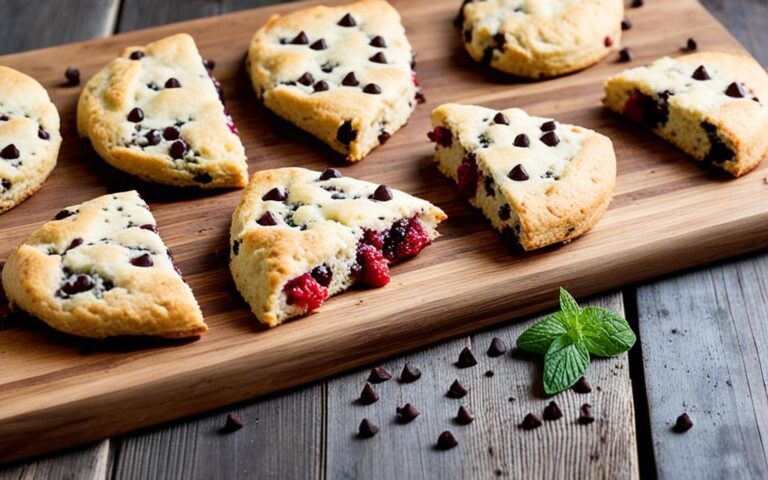Variety Delights: Assorted Scones Recipes
Views: 6
Welcome to a delightful journey with assorted scones from the United Kingdom. These pastries have become a must-have at tea parties and brunches worldwide.
What makes assorted scones so special? Maybe it’s their soft, crumbly texture or the amazing smell as they bake. Or perhaps it’s how you can try different flavors and toppings with them.
We’re going to explore the rich history of British scones. Plus, we’ll share recipes to make perfect scones. Assorted scones will be the highlight. So, grab your apron and let’s start this tasty adventure.
We’ll focus on authentic flavors, assorted scones, and scone recipes. This will create a mix of inspiration that will make you want more.
A Concise History of British Scones
British scones have a deep history that goes back centuries. They began as simple round cakes made from oats. Scots cooked them over an open fire. This early version was called “bannocks,” loved by Scottish Highlanders. The oats were used because they were plenty in the region.
The recipe for British scones changed over time with new ingredients and ways of baking. They evolved to include flour, sugar, butter, and milk. This made the scones softer and more popular all over the British Isles.
In the Victorian era, scones became a key part of British afternoon tea. They were enjoyed with clotted cream and jam. This tradition of having scones with tea is still loved today.
The history of British scones highlights their importance in food history and British culture. The changing recipe shows how this tasty snack has adapted over time.
For more on British scones’ history, here’s a thought from famous British chef, Mary Berry:
“Scones are as British as the Queen herself. They started as simple oatcakes and became the classic treat we love. This shows the lasting charm of these baked delights.”
British scones have truly lasted through time, bringing happiness to various people. They showcase the UK’s culinary brilliance.
The Evolution of British Scones Across the Centuries
British scones have changed a lot throughout history. They have been shaped by cultural exchanges and local differences. The table below shows how scones have evolved over the years:
| Period | Key Characteristics |
|---|---|
| Medieval Times | Oat-based cakes cooked over an open flame |
| Victorian Era | Introduction of refined flour, sugar, and butter; served during afternoon tea |
| 20th Century | Variations with added ingredients such as currants, raisins, and spices |
| Modern Era | Continued experimentation with flavors and textures; popularity as a versatile treat |
The evolution of British scones shows changing tastes and preferences over generations. They remain a favourite pastry in today’s kitchens.
An Array of British Scone Varieties
The classic plain scone is still loved by many. Yet, British scones now come in many flavors and textures. They have changed over centuries, adding new ingredients, baking methods, and cultural touches. You can find scones with fruits like currants or raisins, or savory ones with herbs and cheese. There’s a scone for every taste and occasion.
Fruit scones bring a sweet and complex flavor. They make the scone’s texture crumbly and interesting. These scones are perfect for afternoon tea or a fancy breakfast. You can enjoy them plain or with clotted cream and jam. They are a delicious mix of sweet and buttery flavors.

Savory scones are something entirely different. They are mixed with rich herbs like rosemary or thyme and have bits of tangy cheese. These scones are great for brunch or with a warm soup. They show how versatile scones can be.
British scones offer a chance to try new things while keeping true to their roots. Whether you like sweet or savory, these variations can make your tea time or breakfast extra special.
Genuine British Scone Recipes: Mastering the Art
We’ve shared two true British scone recipes to delight your taste. Choose from a simple classic or a fruity option. Follow these step-by-step guides for perfect scones every time.
Plain Scones Recipe
Ingredients:
- 300g all-purpose flour
- 50g sugar
- 2 tsp baking powder
- 75g cold butter, diced
- 150ml milk
- 1 tsp vanilla extract
Instructions:
- Heat your oven to 220°C (425°F) and prep a baking sheet with parchment.
- Mix flour, sugar, and baking powder in a big bowl.
- Blend cold butter into the mix until it looks like coarse crumbs.
- In another bowl, combine milk and vanilla extract well.
- Add the wet ingredients to the dry ones and form a soft dough.
- On a floured surface, knead the dough gently a few times.
- Roll the dough to 2cm thickness and cut with a cookie cutter.
- Put the scones on the baking sheet. Brush tops with milk.
- Bake for 12-15 minutes until golden. Let them cool on a rack.
Fruit-Infused Scones Recipe
Ingredients:
- 300g all-purpose flour
- 50g sugar
- 2 tsp baking powder
- 75g cold butter, diced
- 150ml milk
- 1 tsp vanilla extract
- 100g dried currants or raisins
Instructions:
- Start by heating the oven to 220°C (425°F) and lining a baking sheet.
- Combine flour, sugar, and baking powder in a large bowl.
- Cut in the cold butter until the mix resembles coarse crumbs.
- Mix milk and vanilla in a different bowl.
- Pour milk mix into dry ingredients to make a soft dough.
- Mix in dried currants or raisins gently.
- Knead the dough on a floured surface a few times.
- Roll the dough, cut out shapes, and place on the sheet.
- Brush with milk and bake until golden. Cool on a wire rack.
With these recipes, you can easily make delicious British scones at home. They’re easy to follow and create scones that are soft and full of taste. Enjoy them warm with clotted cream and jam for the full British effect.
Conclusion
British Scones are a true delight, showing the simple pleasures of British life. They make any moment special, whether they’re plain or flavoured. Most recipes take only five minutes, so you can enjoy homemade scones fast.
Scones can be adjusted in look, taste, and extras to fit various cultures. Even though people pronounce “scone” differently across regions, the happiness they bring is the same for everyone.
While scones and biscuits come from the same British roots, they are now very different. Scones use cream and eggs, giving a wonderful texture. How you shape them and where you place them on the baking sheet also affects their texture. This can make them either soft and tender or crisp and crunchy.
When baking your scones, make sure you have the right tools. You’ll need a baking sheet, bench scraper, biscuit cutters, and a few more items. Avoid overmixing to prevent the scones from being hard. A good recipe to try can be found here. It will surely bring joy to your taste buds with these wonderful treats.
FAQ
What are the main ingredients used in British scones?
British scones mainly include all-purpose flour, sugar, baking powder, butter, milk, and vanilla extract.
Can I customize the flavors of British scones?
Absolutely! You can make British scones in many flavors. Try adding fruits or make them savory. Feel free to try new ingredients for different flavors.
Are the recipes provided easy to follow?
Yes, our recipes for both plain and fruit scones are simple to follow. They have clear, step-by-step instructions for perfect scones every time.
How can I ensure my British scones turn out delicious?
To make tasty British scones, closely follow the recipe. Use the best, fresh ingredients. Also, work the dough gently.
Remember to preheat your oven. Keep an eye on the scones as they bake. This will help them come out just right.
Can I serve British scones on special occasions?
Absolutely! British scones are perfect for any event. They’re great for tea parties, brunch, or afternoon snacks. Serve them anytime you want a bit of British charm and luxury.
















